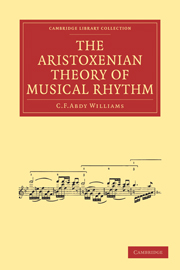Book contents
- Frontmatter
- PREFACE
- Contents
- MUSICAL ILLUSTRATIONS
- INTRODUCTION
- CHAPTER I
- CHAPTER II
- CHAPTER III
- CHAPTER IV
- CHAPTER V
- CHAPTER VI
- CHAPTER VII
- CHAPTER VIII
- CHAPTER IX
- CHAPTER X
- APPENDIX A Quotations, from original sources, of passages referred to in the text
- APPENDIX B Glossary of Technical Terms
- APPENDIX C Dactylo-epitritic, Logaœdic, and Dochmiac rhythms, and rhythmical modulation. M. Laloy's views
- INDEX
- Frontmatter
- PREFACE
- Contents
- MUSICAL ILLUSTRATIONS
- INTRODUCTION
- CHAPTER I
- CHAPTER II
- CHAPTER III
- CHAPTER IV
- CHAPTER V
- CHAPTER VI
- CHAPTER VII
- CHAPTER VIII
- CHAPTER IX
- CHAPTER X
- APPENDIX A Quotations, from original sources, of passages referred to in the text
- APPENDIX B Glossary of Technical Terms
- APPENDIX C Dactylo-epitritic, Logaœdic, and Dochmiac rhythms, and rhythmical modulation. M. Laloy's views
- INDEX
Summary
THE ability to “keep time” must be possessed by every musician if he is to perform intelligently, and to take part in concerted music. In the early days of counterpoint, ere rhythm was thought of, the singers were obliged to “keep time” in order that the various parts might fit each other properly.
When to “keeping time” is added an artistic accentuation and intelligent phrasing, rhythm results.
Musicians give rhythmical life to what they perform, either instinctively, or through the training received from those who have the rhythmical instinct. As a rule, no special study is made of rhythm by itself, and when I met with Westphal's Allgemeine Theorie der musikalischen Rhythmik, it struck me as revealing the rhythm of modern music through ancient theory in such a new and interesting light, that I have for many years wished that my English fellow musicians could share in the pleasure and profit that it has given me.
For an opportunity of bringing this ancient theory before musicians I here express my gratitude to the Syndics of the Cambridge University Press.
While correcting the proofs my attention was called to M. Louis Laloy's remarks on certain forms which have long puzzled investigators, owing to the difficulty of reducing them to musical rhythm as understood by us. His views are novel, and so highly suggestive, that one cannot but think that he has discovered the key to the mystery.
- Type
- Chapter
- Information
- Publisher: Cambridge University PressPrint publication year: 2009First published in: 1911

